Read time: 10 minutes
Note: this is part three of a four-part series — a master guide to reducing DHT levels for hair loss. Missed the earlier articles? Read part one here, and part two here.
Summary So Far: Decrease DHT With Free Testosterone, 5-Alpha Reductase
In the first article, we uncovered what DHT is, how it’s made, the DHT-hair loss connection, and how we can reduce DHT (and maybe fight hair loss) by using four major levers.
- Decrease free testosterone
- Inhibit 5-alpha reductase
- Decrease androgen receptors
- …and one more we’ll reveal in the next article
Then we dove into all the mechanisms by which we can decrease DHT by using the first and second lever: reducing free testosterone and inhibiting 5-alpha reductase.
By the end of the second article, we summarized the mechanisms (but not all the drugs, foods, supplements, and treatments) targeting those first two levers:
But we still have two DHT-fighting levers left.
- Decreasing androgen receptors, and…
- A mystery lever (for the next and final article…)
This article is the third installment to our DHT-reducing mechanism series. We’ll uncover the third major DHT-reducing pathway – and its known mechanisms – in hopes of reducing DHT to slow, stop, or reverse pattern hair loss.
It all builds into our Master Flowchart: A Guide To All Major DHT Reducing Mechanisms To Fight Against Hair Loss.
What we’re covering now: decreasing DHT by reducing androgen receptors. And the research here is pretty exciting (at least to me).
Reduce DHT By Decreasing Androgen Receptors
What Are Androgen Receptors?
Androgen receptors are the places inside a cell where androgens (testosterone, DHT, etc.) attach themselves. After an androgen attaches to an androgen receptor, these androgens can then influence a cell’s function.
Remember: DHT forms when free testosterone interacts with the enzyme type II 5-alpha reductase and converts that free testosterone into DHT. Then that DHT binds to a cell’s androgen receptor, where it influences that cell (and tissue). In the case of pattern hair loss, the kind of DHT people want to reduce is scalp tissue DHT.
Think of androgen receptors like a landing pad for DHT. Without an androgen receptor, DHT can’t attach to the cell and influence its function. And in the case of pattern hair loss – without androgen receptors, DHT can’t attach to scalp tissue DHT (the kind of DHT associates with hair thinning).
How Can We Decrease Androgen Receptors?
There are at least three ways to decrease influence receptors…
- Decrease total androgen production
- Decrease androgen receptor expression
- Block androgen receptors
Let’s dive into all three. We’ll give a few examples pertaining to each pillar, but this article is by no means an exhaustive list of strategies.
#1: Decreasing Total Androgen Production
We’ve actually covered this method before – albeit for reducing DHT via free testosterone. And to reiterate: this is a bad idea.
For instance, one way of blocking our body’s ability to produce androgens (and thereby reducing androgen receptor expression) is castration. Another way is to take drugs that change the brain signaling pathways in our hypothalamus so that our bodies convince themselves they need to produce less testosterone to thrive.
Yes, blocking total androgen production significantly decreases androgen receptor activity (likely because there are fewer total androgens available). But doing so comes attaches to serious side effects. And the costs of these side effects far outweigh any benefit to DHT reduction and hair health.
The consequences of this kind of DHT-reducing approach? Low/no libido, depression, sexual dysfunction, the list goes on. So when it comes to safely decreasing androgen receptors, please consider all other options aside from reducing total testosterone production.
In any case, here’s what this looks like in a flowchart:
Fortunately, there are other ways to target DHT by reducing androgen receptors. For instance: decreasing androgen receptor expression.
And this is where it gets interesting.
#2: Decreasing Androgen Receptor Expression
When we talk about decreasing androgen receptor expression, we’re not talking about manipulating androgen receptor activity by taking away the thing that tells our bodies to activate them – the androgens themselves. Instead, we’re talking about changing the actual environment of our tissues – so that fewer androgen receptors activate in those tissues.
One potential way to decrease androgen receptor expression?
Increase tissue oxygen levels.
Hypoxia (Oxygen Restriction) Increases Androgen Receptor Activity
In the prostate, reduced oxygen levels – in combination with DHT – dramatically increases androgen receptor activity. In fact, it increases androgen receptor expression six-fold versus DHT alone.
Why is this interesting? Well, an enlarged prostate and men’s balding scalps have a lot in common.
For one, our prostates and our balding scalp regions both use the enzyme type II 5-alpha reductase to convert free testosterone into DHT – and not other forms of 5-alpha reductase.
In addition, high DHT levels are associated with both balding scalp regions and an enlarged prostate.
But even more interesting? Hypoxia (lower oxygen) is associated with both prostate cancer and regions of the scalp which are balding.
Could the increased DHT we see in balding scalps somehow be connected to hypoxia? Possibly. Especially when we consider how androgen receptors, in the presence of DHT and hypoxia, express 6-fold higher than in the presence of DHT alone.
What does all this mean? We can probably reduce DHT levels by decreasing androgen receptor expression. And how can we do that? By increasing oxygen tissue levels.
If We Increase Scalp Tissue Oxygen, Can We Reverse Hair Loss?
The evidence on oxygen therapies, DHT levels, and hair growth in humans is essentially non-existent. So, we don’t know.
Anecdotally, I’ve spoken with two people who tried hyperbaric oxygen therapy and said that it regrew their bald vertexes over a period of four months. And there’s also a patent on injectable ozone for hair loss sufferers, with cited case studies.
With that said, there’s not enough evidence to say that increasing oxygen is a viable option for 1) reducing androgen receptors, 2) reducing DHT levels, or 3) regrowing hair. There are anecdotes, but no hard data.
Another challenge with oxygen: delivery. Just because we inhale pure oxygen doesn’t mean we actually raise tissue oxygen levels. This is probably why future hair loss therapies using oxygen will come in the form of injections rather than hyperbaric chambers – if at all.
But the bottom line: if we increase tissue oxygen levels, my bet is that this will 1) decrease androgen receptor activity and 2) encourage hair regrowth.
So let’s summarize our mechanisms (so far) for decreasing androgen receptors:
This brings us to our last mechanism to reducing androgen receptors: blocking them. And if you’ve tried many hair loss drugs or keep up with hair loss research, there’s a good chance you know what’s coming.
#3: Blocking Androgen Receptors
What does it mean to block androgen receptors?
In simple terms, it means to bind something to an androgen receptor so that the androgen receptor is “blocked off” from binding with actual androgens, like testosterone or DHT.
That’s how androgen receptor blockers reduce DHT: the AR blockers bind to a cell’s androgen receptors and prevent DHT from binding to that same cell. In effect, that DHT can no longer influence that cell’s function.
Androgen receptor blockers come in two forms: steroidal and non-steroidal. And like steroidal 5-alpha reductase inhibitors, steroidal androgen receptor blockers are also synthesized from hormones like progesterone.
#1: Steroidal Androgen Receptor Blockers – Spironolactone
When it comes to hair loss (and reducing DHT), a popular androgen receptor blocker among women is a drug called spironolactone (branded as Aldactone). This is an androgen receptor blocker derived from the hormone progesterone.
Spironolactone reduces DHT by blocking androgen receptors, and doctors often prescribe this drug in oral form for women suffering from female pattern hair loss or even hirsutism – unwanted body and facial hair growth. This is because increased DHT is associated with hair loss in the scalp, but ironically, hair growth in the body and face.
Spironolactone is a powerful anti-androgen. In fact, most men are advised against taking it orally as a hair loss treatment. Why? It can be feminizing. In fact, oral spironolactone is the same drug some men use to transition genders and become female.
However, spironolactone also comes in topical form – so we can concentrate its anti-androgen receptor effects to our scalps and minimize the risk of feminization.
#2: Non-Steroidal Androgen Receptor Blockers – RU58841
Aside from not being derived from hormones, the major difference between steroidal vs. non-steroidal androgen receptor blockers is that non-steroidal AR blockers are what we call “silent” androgen receptor antagonists. In other words, they block androgen receptors without actually activating them.
Two examples of non-steroidal androgen receptor blockers for hair loss?
- Flutamide. Historically, this drug was mostly geared for female pattern hair loss sufferers and men with advanced stage prostate cancer. But recent advents in topical delivery via nanoparticles might make this drug effective for hair loss – and maybe even devoid of major side effects.
- RU58841. In the past few years, RU58841 made the rounds on hair loss forums, but it has yet to legally make it to the US market (technically, you can still get your hands on it – albeit for “research” purposes only).
The side effects of non-steroidal androgen receptor blockers aren’t fully understood, so unfortunately I can’t say much. What I will say: when it comes to any anti-androgen – do your research, understand the risks, and exercise caution.
Now let’s add all of this to a flowchart:
Reduce Androgen Receptors: Summary
When it comes to reducing DHT by decreasing androgen receptors, there are three major ways we can go about doing this:
- Decrease total androgen production
- Decrease androgen receptor expression
- Block androgen receptors
Here’s a summary of the major mechanisms behind each way:
Again, this article series is only here to present a handful of angles and mechanisms for DHT reduction; it’s not here to compare these angles against one another (as most of them haven’t been studied for the treatment of pattern hair loss).
In any case, let’s add these discoveries to our master flowchart, which is just one article away from completion. (The chart is getting big, so click on it to enlarge.)
What’s Next…
When it comes to reducing DHT in hopes of stopping hair loss, we’ve covered…
- Free Testosterone
- 5-Alpha Reductase
- Androgen Receptors
But there’s still a fourth DHT-reducing pillar we haven’t discussed. What is it?
In fact, research in increasing DHT metabolism might hold promise for hair loss sufferers looking to decrease scalp tissue DHT but avoid the sexual side effects of DHT reduction. This is all covered in the next (and final) article – where we will complete our Master Guide To The Mechanisms Behind DHT Reduction.

Rob English is a researcher, medical editor, and the founder of perfecthairhealth.com. He acts as a peer reviewer for scholarly journals and has published five peer-reviewed papers on androgenic alopecia. He writes regularly about the science behind hair loss (and hair growth). Feel free to browse his long-form articles and publications throughout this site.

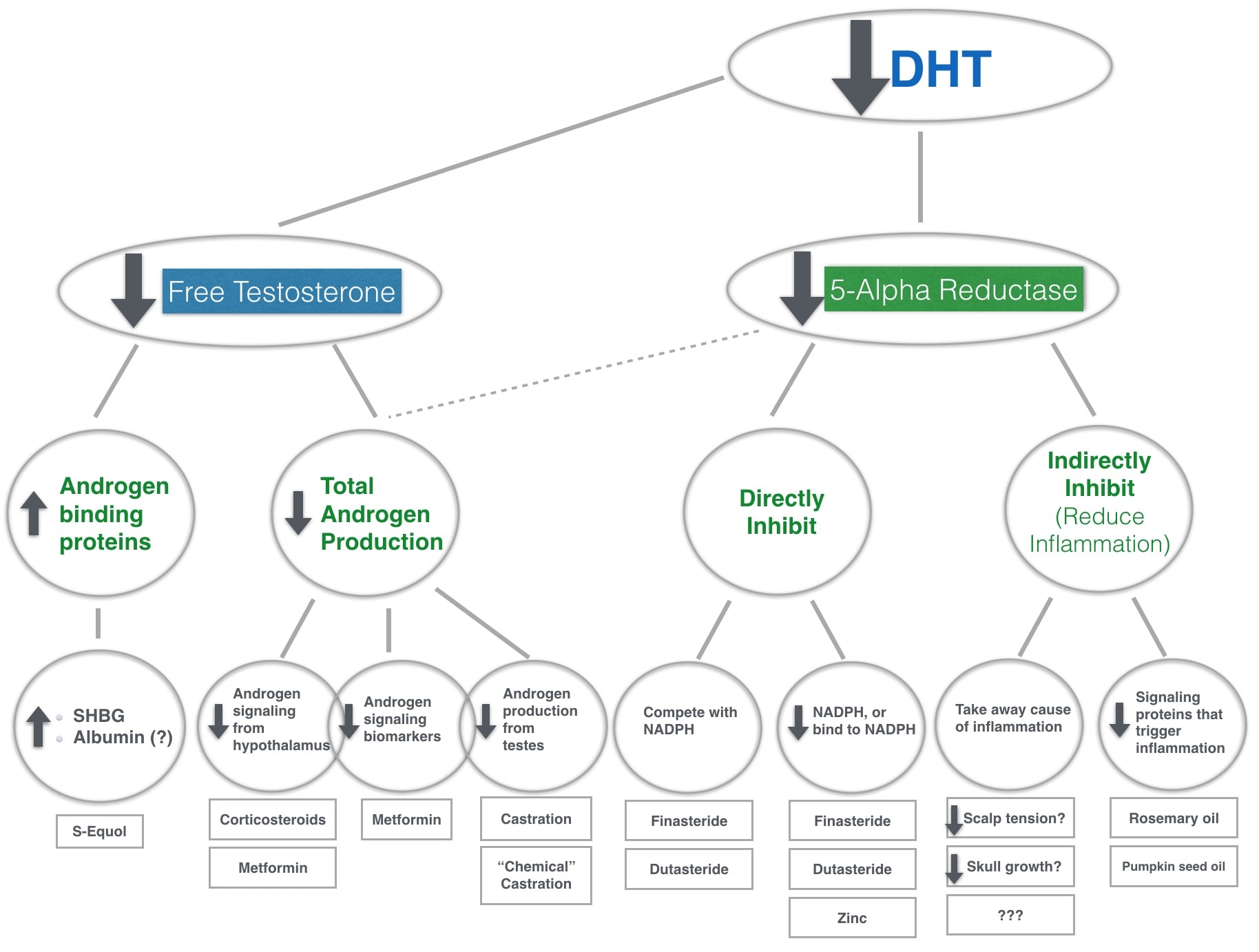

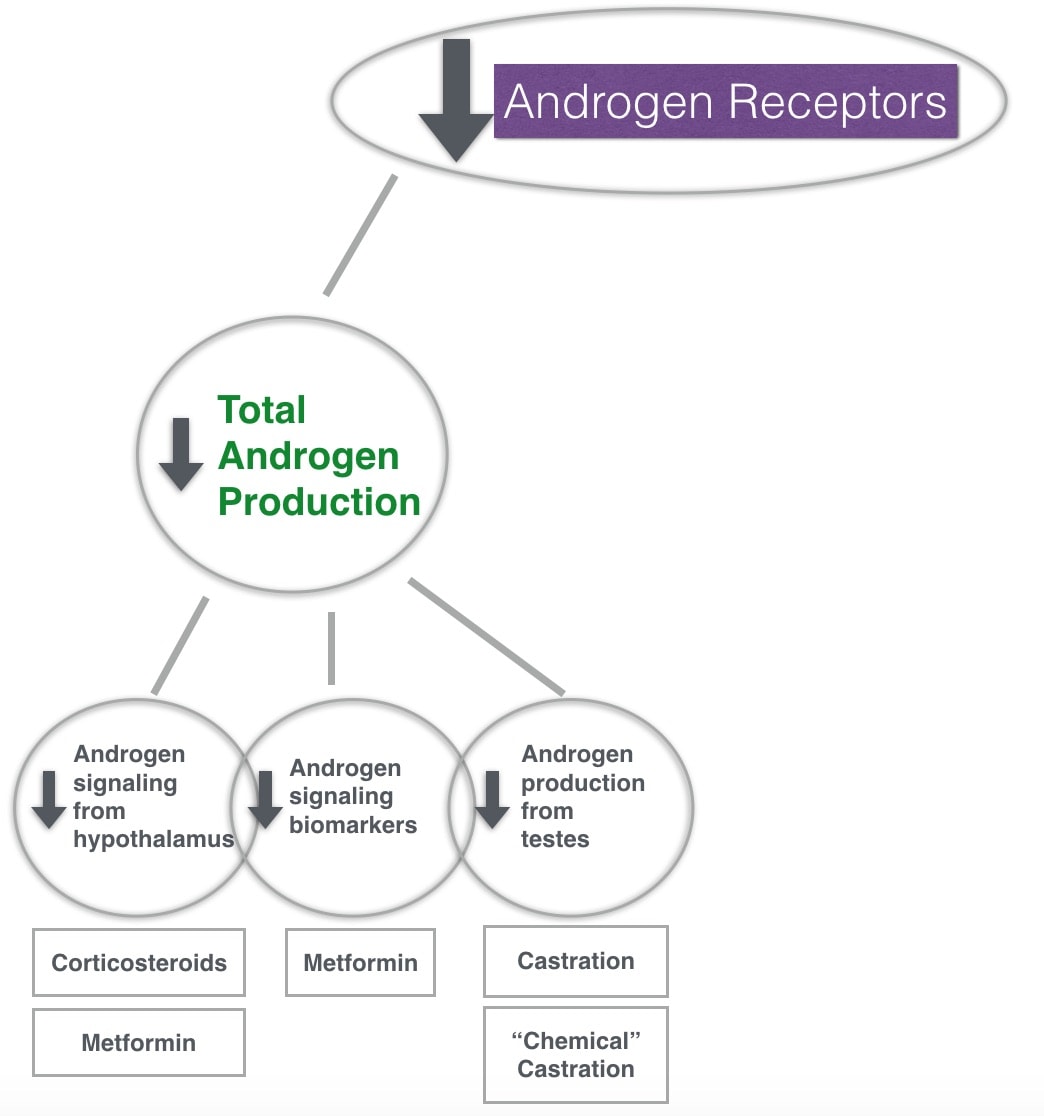
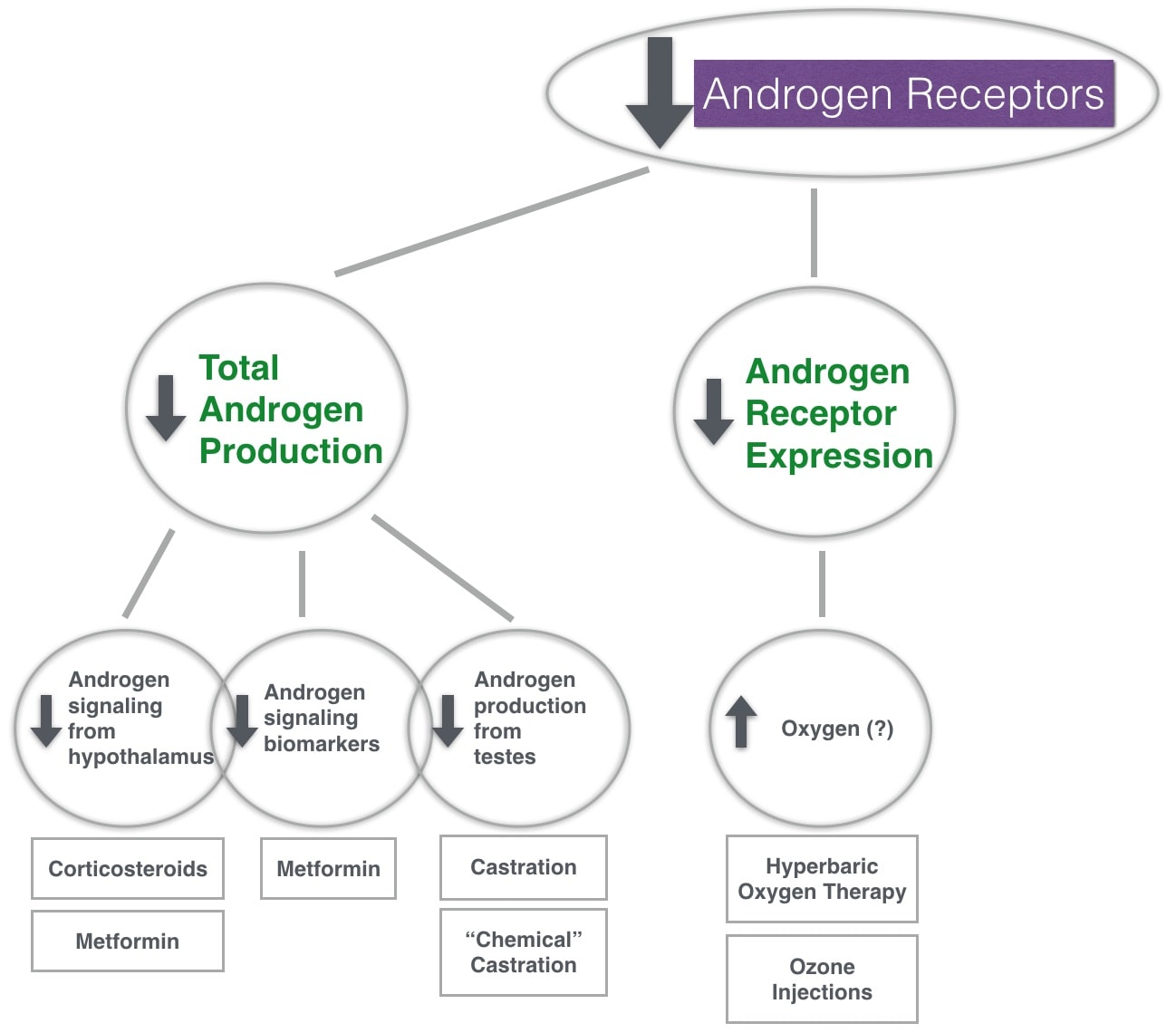

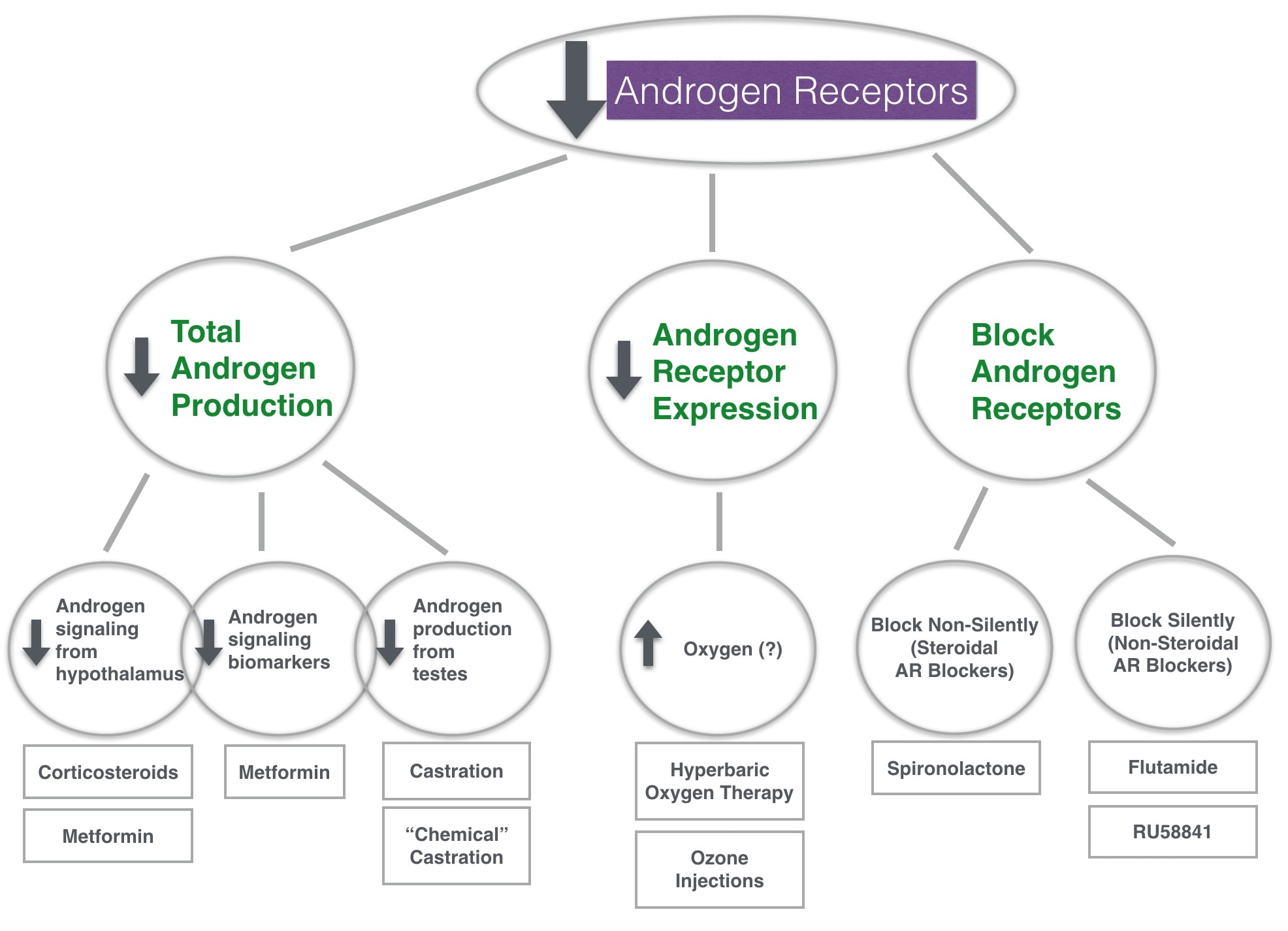
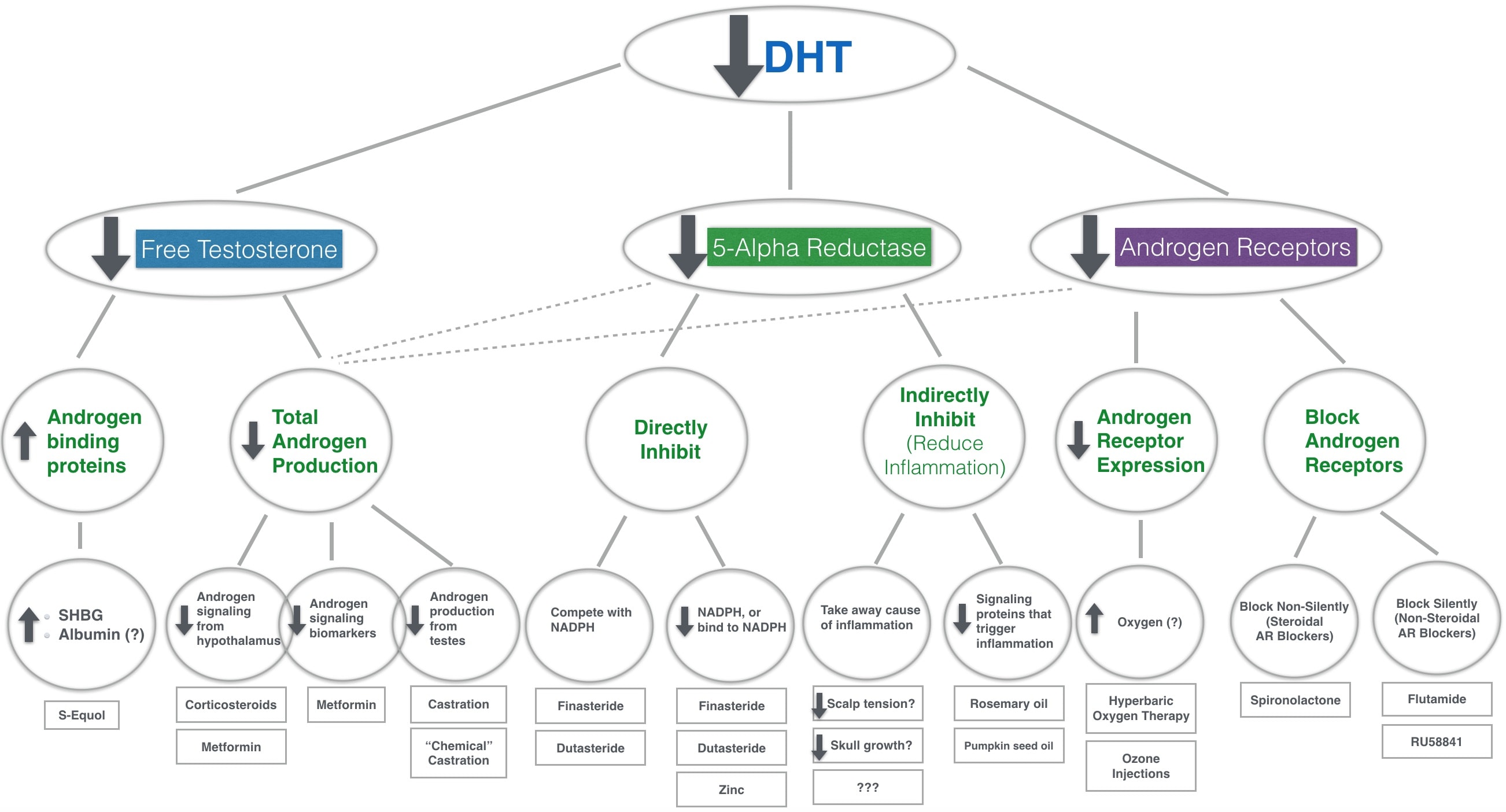
Danny Roddy talked about CO2 being one of the factors of hair growth, we could achieve this by practising breathing through our noses only (Buteyko). Have you heard about this?
It’s possible that deep breathing (Wim Hof exercises) or even elements of Buteyko (nasal breathing) could help. I think the real issue though is oxygen delivery to the affected scalp tissues. Just because we increase blood oxygen levels, doesn’t mean we’ll increase oxygen levels of chronically inflamed tissues. And while you’d think this would be more studied, it’s not! Which is disappointing…
But the oxygen-hair loss connection seems pretty evident. For instance, just look at this review on chronic wounds and all the growth factors upregulated as a result of reduced oxygen: MMP2, MMP9, transforming growth factor beta… all the typical signaling protein players that we also see in pattern hair loss:
http://www.medscape.com/viewarticle/727614_3
I’ve read a bit about CO2 (I remember one of Danny Roddy’s articles from a while back on CO2, neonatal pattern hair loss, and CO2 as an opposer of the effects of prolactin). I don’t think there’s strong enough evidence to say with certainty that CO2 therapies will help with hair loss, but they’re certainly worth trying. I know of a few people who’ve used bag-breathing as part of a “kitchen sink” approach to hair regrowth – and with some success. It’s hard to say how much of their hair growth came from CO2 versus the dozens of other things they were doing – but we still can’t rule it out.
Thank you for the detailed answer. I sent you an email Rob
Is this the reason that Minoxidil works to regrow hair? In that more blood flow = more oxygen.
Hi Rob
Thanks for your interesting articles
I don’t have hair loss :)) but I have increased DHT (1.5 times above the upper border). Also I have high T level (the doctor says too high for my age and I’m 51). I have been taking levitra (similar to viagra) on a regular basis during the last year (~twice per week). Do you think it may have increased DHT?
The doctor does not believe it…
Hey Yuri,
Thanks for reaching out. With high T and DHT levels, I’m not surprised that you’re not dealing with any hair loss! Evidence suggests that serum (blood) DHT is uncorrelated with, or even protective against, pattern hair loss! I’m guessing your doctor measured your serum DHT, and not necessarily your tissue or saliva levels.
https://perfecthairhealth.com/men-stop-thinking-your-hair-loss-is-due-to-high-testosterone/
From my understanding, Levitra is a PDE-5 inhibitor. There’s little to no research on PDE-5 inhibitor’s effects on testosterone and DHT levels (at least that I could find). But interestingly, it appears that when it comes to treating erectile dysfunction, a PDE-5 inhibitor + testosterone therapy appears to work better than PDE-5 inhibitors alone.
https://www.ncbi.nlm.nih.gov/pubmed/25643866
With that said, it’s still unclear whether PDE-5 inhibitors effect T or DHT levels. But in my opinion, it shouldn’t be out-of-question.
What is your opinion on this product? Is really expensive but seems to tackle all of the main issues of hair loss that you are also tackling on here https://kourosh.com/products/alopecia-morphogene
It attacks the issues of fibrosis, blood circulation and DHT on the scalp
Those ingredients all might help with hair loss, but I’m not in love with the product. For one, you could buy all those indredients individually and mix them yourself for a fraction of the price $123.00. They’re all easily sourced from Amazon.
Secondly, that sites claims 25,000 daily users of their product. I don’t see a single before-after photo. Just stock photography. Not to say that stuff wouldn’t work, but I’m of the belief that if a program or topical can regrow hair, and if you have thousands of customers, you also better have visual validation. I’d say save your money!
Hi Rob,
impressive research. Impressive communication skills.
I would like to come back to the idea that DHT is actually a hair growth promoter (to all body and scalp hairs). This said to explain the hair loss on scalp is not a problem :
– pressure increase in the scalp by : gravity + loose of quality of the connective subcutaneous tissue between skin scalp and Galea = oxygen and nutriments missing = triggers the over-expression of the DHT androgen receptors of follicles (the mecanism is a call for hair growth stimulatin, .. but unfortunately in excess and during many years, leading to overproduction of hair and exhausting effect, leading to follicle miniaturisation. This point is documented by a scientific paper, i can send you the one if your are interested.
So to me, the point is how to TEMPORARY decrease (a little) the excess of DHT into scalp to calm down the bad cycle, and clean the scalp. Then in a second phase, the idea is to re-thicken the scalp subcutaneous layer in order to recreate the proper equilibrium of oxygen, blood flow, androgen level and AR susceptibility. The body is actually well made and capable to adapt.
I would like to discuss further this point with you, please send me a private email address I can write to you to further expose my point of view and my analysis.
Rob, I am sure I have here the key of the root cause of hair loss, but I am not saying I have the key to counteract it. Nevertheess with the knowledge I have today, I would have behaved differently at age of 20 for my scalp health.
BR
Patrice
Thanks for commenting Patrice!
I think I’ve seen the paper to which you’re referring – The Gravity Theory Of Baldness. There are a few alternative theories to pattern hair loss that I’m sure you’ve come across in your research. I broke down the major ones here, and also brought to light a few major holes in each theory:
https://perfecthairhealth.com/the-leading-theories-of-pattern-hair-loss/
I know you’ve commented on that post so I’m assuming you’ve also read through it. Just wanted to share with those who are following your comments.
I agree with your sentiments about DHT, since tissue DHT in the body and face are associated with hair growth, and the only place in our body where DHT encourages hair loss is in the scalp. This suggests that DHT + at least one more factor trigger scalp hair loss. I took this theory as far as I could here:
https://perfecthairhealth.com/the-ultimate-hair-loss-flowchart-why-we-lose-our-hair/
The reality is that we haven’t done enough research into the etiology of hair loss to take this any further. Which is unfortunate – especially when we consider how much money goes into hair loss treatment developments (in the US especially, doctors try to treat the disease first without every fully understanding its causes).
I’m happy to have a conversation. You can get my email address by signing up in an opt-in anywhere on my site. But I would like to keep the dialogue going in the comments, too. Readers of this site are typically very scientifically literature. They enjoy reading new ideas, and as a result, I’m sure they’d also love to read yours.
Best,
Rob
This is an interesting concept, coupled with the hyperbarric oxigen chamber idea, and dilating blood vessels being propagated, perhaps the cells are starved and somehow induce inflammation for that reason, but I dont want to jump anywhere without research that could validate it. it is also worth noting the parts of the scalp that have muscles dont experience balding.
there are methods that induce high blood pressure in the scalp area for short periods once a day that are used to grow hair at an accelerated rate and have worked surprisingly well for me personally. It would stand to reason to consider the opposite to be true too.. less blood flow less growth.
there is a product by the name if Acell that has a strong concentration of healing compounds that is used with great success in wound repair as well as to greatly increase the success of hair transplants. Iv heard of a practitioner in LA that uses this compound with PRP to regrow hair, He seems to have a legitimate following and I have seen very poor results from PRP alone elsewhere.
There are other compounds such a peptides ie. BCP-147 that have excellent healing properties and are known to encourage new capillaries to form in the injection site for upto 15cm
I tried years ago to order Acell and was refereed to a distributor with no interest in supplying.
Im hoping to try again soon
to get to try any of these solutions you would need to find yourself a one in a million doctor who would likely charge half the price of a small car. its a sad reality
Thanks for the comments, Nick. And I agree – the prices of some of these treatments (regardless of their success rates) are far too expensive. I’ve had several readers who’ve paid several thousand dollars for a series of PRP + Acell treatments only to report increased shedding. It’s a frustrating reality for most hair loss sufferers.
I’ll look into BCP-147 and get back to you. And if I hear of any practitioners offering hyperbaric oxygen chambers at an affordable rate to treat calcification, fibrosis, or other hair loss-related conditions, I’ll be sure to reach out.
I’m heading to Los Angeles in two months (I’ll be down there for at least a few weeks) and will try to track down that practitioner to hear what else he’s doing differently. If he allows me to share anything, I’ll be sure to post it on the site.
Best,
Rob
Hi Rob. I’m new to this site and I just signed up to get more information. I know nothing much about how to prevent Androgenic Alopecia. I just wanna ask you a to-the-point question. Is there any natural or non-surgical way to prevent Androgenic Alopecia permanently? I have done a simple research and what I got is the only way to prevent it permanently is doing hair transplant procedure. So, what do you think?
Note: Sorry for my bad english.
Thanks Rob.
Hey Charlie,
Thanks for reading and reaching out. And yes, there are several non-surgical approaches to preventing pattern hair loss. For instance, taking Finasteride (or any other drug that reduces DHT to castrate levels) before the onset of pattern hair loss and throughout the rest of someone’s adult life. Unfortunately this option is typically off-the-table for many people — as finasteride use long-term is associated with side effects that many men consider worse than hair loss (like erectile dysfunction).
In terms of natural approaches, it all depends on how you define natural. When it comes to hair loss, prevention is much easier than reversal. A good diet, lifestyle, and mechanical stimulation techniques (pinching, pressing, stretching the scalp) should go a long way toward staving off AGA onset.
Hair transplant procedures won’t prevent hair loss — but they will cosmetically mask hair loss, at least for a while.
Best,
Rob
Wondering if you have any insight to my situation. Short version, I took propecia and move to dutasteride after propecia quit working. Had success and no noticeable side effects. Wanted to gain more so I tried topical RU with ethanol as the vehicle. It gave me sexual side effects. I quit using it and a year later still having issues. Had blood work…LH and FSH were solid, total test was over 1000 ng/dL, estradiol and prolactin we’re in the upper range of normal. I’m now wondering if the RU has remained attached to androgen receptors systematically. That’s why my total test is pretty high, it has no where to bind. Seem possible? Any thought on correcting this issue?
Hey JB,
Just to clarify, are you still taking dutasteride, or have you also stopped taking it in addition to RU? If the former, the challenge here is that there are a few moving variables here re: treatments, and it would be unwise of us to assign blame to RU without also acknowledging the possibility that these side effects may be a delayed onset from Dutasteride use. Research on this is still in its infancy, and while there are a few research teams currently working to identify which polymorphisms or environmental triggers are most closely associated with sexual side effects from 5-AR inhibition, even fewer are studying the side effects of 5-AR inhibitors used alongside other anti-androgens like RU.
Your blood work seems relatively normal for someone taking a 5-AR inhibitor. Total testosterone and estradiol increase in men taking finasteride / dutasteride. RU58841 has a relatively short half-life — one hour, with its anti-androgen metabolites having a half-life of up to 20 hours. Based on this and your blood work, my best bet is that 1) you’re still likely taking dutasteride, 2) you’re likely experiencing delayed onset side effects of dutasteride, and 3) RU may have had an interaction, but based on its half-life alone, it cannot explain your persistent side effects one year later.
I’m also open to being wrong about all of this — but based on the data, that’s my best guess.
Best,
Rob
Hello, I am a 25 year old female who for years suffered from hair loss. After countless hours spent on the internet and reading medical journals cover to cover, I found a temporary solution to my hair loss. I started taking a birth control pill which contained a progesterone derived from Spironolactone. Within months my hair loss stopped- pretty much completely. My hair looks normal again & I’ve now gone over a year without thinking about my hair every minute of the day!
Well, now that I am getting older & am in a long term relationship, I can’t help but wonder, what will happen when I want to have kids and will need to stop taking birth control? This is what has led me to your site. I am seeking advice in my next approach to battling DHT. My biggest fear is stopping this birth control and having my hair loss come back in full swing. I need a new solution that is conducive to pregnancy & for the long term.
Any advice is greatly appreciated!
Hey Nicole,
This is a challenging situation, since androgen receptor blockers like spironolactone can help improve hair loss outcomes drastically for women, but at the same time, create a dependency on the medication to keep the results (like finasteride for men).
In my experience with female readers, female pattern hair loss is often linked to at least one of the following:
-PCOS
-SIBO
-Hypothyroidism
-Hyperparathyroidism
-Nutrient deficiencies (typically vitamin D, B-12, and iron — and often exacerbated by SIBO)
These conditions often compound with each other, and while a medication like spironolocatone (or birth control) can often mask some of their symptoms (like hair loss), you might want to consider getting tested for all of the above. In my experience, the women who test for and successfully treat these conditions quickly see a resolution in their hair loss — and improvements in several other health aspects (including fertility). This could eliminate the need for you to take birth control as a means to stop hair loss, and at the same time, allow you to have children when the time comes.
Best,
Rob
I really like the part about how hypoxia (lack of oxygen) increases receptor activities.
It makes me think of numerous studies showing connection between cardiovascular and thinning crow :
https://www.tandfonline.com/doi/abs/10.3109/08037051.2015.1111021?journalCode=iblo20
Cardiovascular diseases can be linked to lack of exercising, do you think exercising could increase blood flow thus reducing hypoxia ?
Thanks
Hey Anthony,
I wrote a three-part series about the exercise-hair loss connection, which you can read here:
https://perfecthairhealth.com/part-1-of-3-the-exercise-and-hair-loss-connection/
https://perfecthairhealth.com/part-2-of-3-the-exercise-and-hair-loss-connection/
https://perfecthairhealth.com/part-3-of-3-the-exercise-hair-loss-connection/
Cardiovascular disease and pattern hair loss are certainly linked. The confounding factor: androgens! Androgens, under the wrong circumstances, encourage the onset of fibrosis and calcification — both of which are implicated in both AGA and heart disease.
Best,
Rob
“In the prostate, reduced oxygen levels – in combination with DHT – dramatically increases androgen receptor activity. In fact, it increases androgen receptor expression six-fold versus DHT alone.”
HI Rob, could you please share this study? Seems interesting but I can not find anything online about this 6 fold thing, thanks in advance
Hey Alex,
Thanks for flagging this — I didn’t realize I hadn’t linked to the study. It’s right here:
https://www.sciencedirect.com/science/article/pii/S0006291X12000423
These studies are also related (and helpful):
https://www.sciencedirect.com/science/article/abs/pii/S0960076010003602
http://cancerres.aacrjournals.org/content/66/10/5121
Best,
Rob
Rob,
Have you heard of people using RU58841 and results wane over time and their hairloss actually gets worse? If I remember from some years back the theory was that the Androgen Receptors in the hair follicles either upregulates (adding even more androgen receptors) or the receptor mutates in some way where it’s impacted negatively allowing either Testosterone or other hormones to interact with it more resulting in hairloss.
I’m considering adding RU to my regime but I’ve always been a little fearful of this. Thoughts?